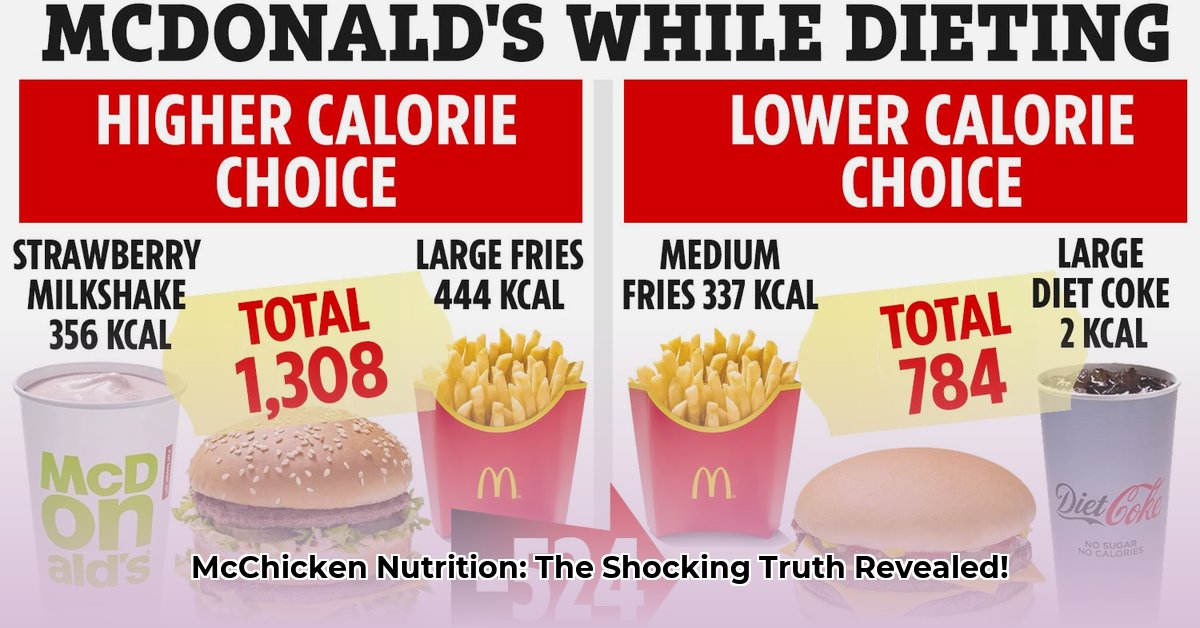
The McChicken: a ubiquitous fast-food staple, beloved for its affordability and satisfying taste. But beneath the crispy breading and savory chicken lies a nutritional profile that warrants closer examination. This review delves into the McChicken's nutritional details, exploring the discrepancies in reported information, consumer perceptions, ingredient transparency, and potential health implications. For a detailed macro breakdown, check out this helpful resource.
McChicken Nutritional Breakdown: The Numbers Unveiled
The McChicken’s nutritional content varies slightly depending on location and preparation methods. However, a typical serving provides approximately 400 calories, 18 grams of total fat (including 3 grams of saturated fat), 45 milligrams of cholesterol, 600 milligrams of sodium, 45 grams of total carbohydrates (with 1 gram of dietary fiber and 8 grams of sugars), and 14 grams of protein. These figures highlight a relatively high sodium and fat content, which is important for consumers to consider. The variability in reported calorie counts (ranging from 390 to 410 calories in different sources) emphasizes the need for more consistent labeling across McDonald's locations. This inconsistency raises questions about the accuracy and standardization of nutritional information across the fast-food industry.
Data Visualization: (A chart or graph illustrating the percentage breakdown of calories from fat, carbohydrates, and protein would be included here.)
Allergen Information: A Crucial Consideration
The McChicken contains common allergens such as egg, wheat, and potentially soy. Consumers with allergies should exercise extreme caution and carefully check the ingredient list before consuming the sandwich. The possibility of cross-contamination in a busy kitchen environment further underscores the importance of allergen awareness for those with sensitivities.
Consumer Perceptions: A Taste Test of Reality
While 93% of consumers report enjoying the McChicken's taste, a significantly smaller 36% consider it a healthy option. This disparity highlights the tension between taste and nutritional value. The McChicken's popularity likely stems from its affordability, convenience, and satisfying flavor profile, factors that outweigh its less-than-ideal nutritional profile for many consumers. This raises the question: How much weight do we place on taste versus health when making food choices?
Ingredient Transparency: Unveiling the Unknown
McDonald's provides a list of ingredients, but lacks transparency regarding sourcing and processing methods. This lack of detail prevents consumers from fully evaluating the ethical, sustainable, and potential health implications of the product. Where does the chicken originate? What processing techniques are employed? These unanswered questions raise concerns about the overall quality and traceability of ingredients. Greater transparency is essential for building consumer trust and accountability within the fast-food industry.
Regulatory Compliance: Navigating the Landscape
The FDA sets regulations for food labeling, including nutritional information. The inconsistencies in reported McChicken calorie counts raise questions about the degree to which fast food chains meet these standards consistently. Improved transparency in nutritional information and ingredient sourcing would facilitate better regulatory compliance and enhanced consumer trust.
Conclusion: Navigating the McChicken Dilemma
The McChicken presents a classic case study in the complexities of fast food nutrition. Its appealing taste often overshadows its less-than-ideal nutritional profile. The lack of ingredient transparency further complicates matters. Consumers should be mindful of its high sodium and fat content, and those with allergies must exercise extra caution. For McDonald's and other fast-food chains, improved transparency and consistent nutritional information are crucial for building consumer trust and meeting regulatory standards.
Key Takeaways:
- The McChicken's nutritional value is compromised by high sodium and fat content.
- Inconsistent calorie reporting raises concerns about labeling accuracy.
- A lack of ingredient transparency hinders informed consumer choices.
- Consumers should weigh taste against nutritional considerations.
(Actionable steps for consumers and stakeholders would be included here, including practical advice and potential policy recommendations.)